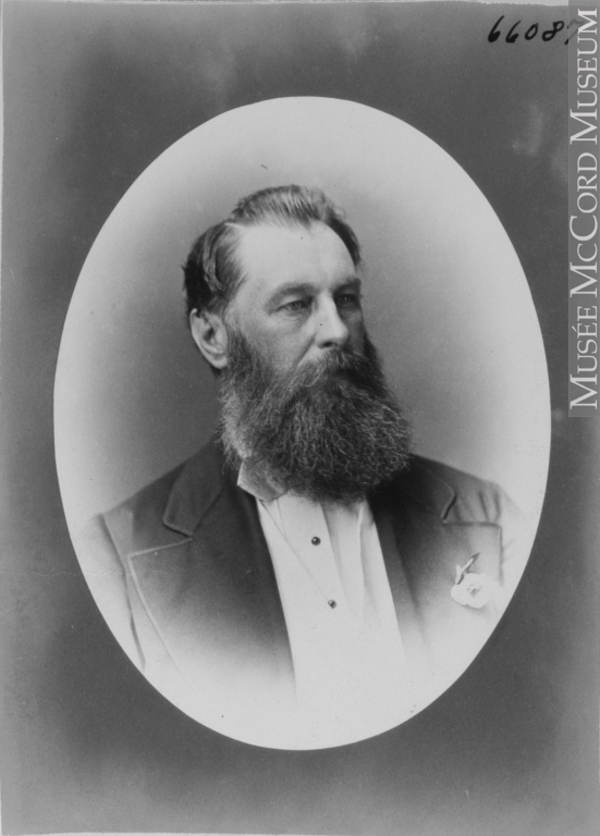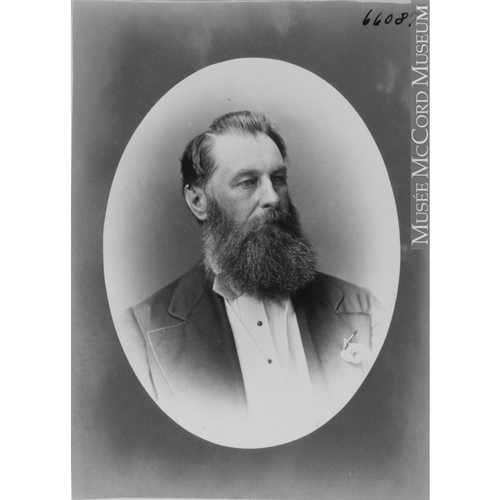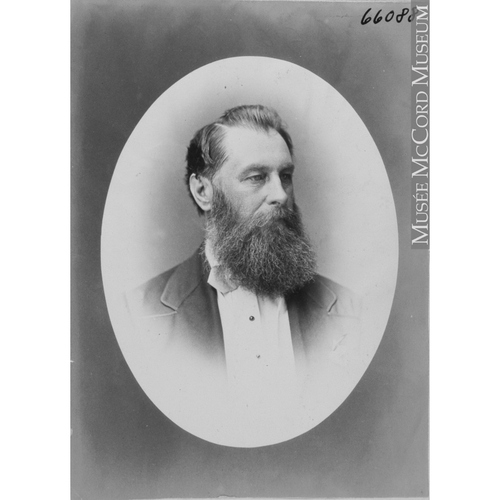
Source: Link
STORM, WILLIAM GEORGE, architect and militia officer; b. 29 Oct. 1826 in Burton-upon-Stather, England, son of Thomas Storm and Mary Hopkins; m. 3 Jan. 1882 Agnes Cotterill in Toronto, and they had one son and three daughters; d. there 8 Aug. 1892.
William George Storm immigrated to Upper Canada with his parents, who settled in York (Toronto) about 1830. They were devout Methodists and for a brief period they sent him to be educated at Upper Canada Academy in Cobourg. Some years later he joined his father, a prominent contractor, in the building trade and in the summer of 1845 he suffered a near-fatal fall from a scaffolding. His artistic ability and knowledge of construction had directed him toward architecture and he was articled to William Thomas* in Toronto. A contemplated move to California was cancelled when in late 1848 or early 1849 he entered the office of Frederic William Cumberland*, where he assisted with the preparation of working drawings and details and developed his considerable gifts as a delineator. In July 1852 he was taken into partnership, a working association that lasted about a dozen years, during which time Cumberland and Storm was one of the leading architectural firms in the province.
A difficulty arises in attempting to assess Storm’s place within the partnership. Cumberland, with his family, social, and business connections and his entrepreneurial skills, undoubtedly remained in charge of enlarging the firm’s clientele and negotiating its contracts. During the partnership’s early years he probably contributed the creative ideas as well, but his growing involvement with railways would have increasingly necessitated delegating responsibilities to Storm, especially with respect to the delayed completion of the cemetery chapel of St James-the-Less. In the preparation of the design for their major monument, University College (1856–59), Cumberland crossed the Atlantic to study collegiate schemes abroad. Storm followed in the fall of 1857, visiting England, Ireland, France, and Germany. The trip enabled him to enlarge his professional background and to gather material that would not only be immediately useful in the completion of the college but would also influence his later work.
Although Cumberland’s effective participation in the partnership seems to have ended after 1863, the firm name continued in use until 1866. During this transitional period, a number of projects in Toronto were undertaken solely by Storm. In 1862 he designed the Northern Railway’s office building and in 1865 he added the tower to St James’ Cathedral, with only slight changes from Cumberland’s 1850 design. Storm’s connection with Osgoode Hall, the centre portion of which had been executed by Cumberland and Storm, was maintained in 1866 when he designed the cast-iron fence that remains an ornament to Queen Street. The most prestigious commission to come his way in this period was the design of the Great Western Railway station, completed in 1866, which was destroyed by fire in 1952. Planned with a rational separation of functions, the station’s barrel-vaulted train shed and passenger facilities with Italianate detailing effectively rendered in wood provided a picturesque conclusion to the south end of Yonge Street. The dissolution of the partnership was marred by a dispute largely attached to losses from the firm’s investment in property in Toronto and Nottawasaga Township. The suit that Storm launched against Cumberland was settled in 1871 with Cumberland retaining the property and Storm being freed of financial obligations.
After Cumberland and Storm, except for a brief period of partnership in 1877 with Charles Albert Walton, Storm worked on his own. The development of his independent practice was marked by struggle: much of his work consisted of modifications to existing buildings or was related to projects carried out during the partnership, and it was almost without exception confined to Toronto. Possibly deriving from a physiological weakness or even from his fall in 1845, ill health twice interrupted his career. In the spring of 1873 he sought treatment at the Clifton Springs Sanitarium in New York State. A few years later he became a patient at the Toronto General Hospital, where by July 1878 he was assuming minor architectural duties for the hospital in return for medical care and an office. He remained at the hospital into 1879, and there made the acquaintance of William Holmes Howland, chairman of the hospital board, who, through his involvement with various charitable institutions and the Church of England, was to prove a valuable friend.
Another important connection was Emerson Coatsworth, a prominent Methodist, city commissioner, and chairman of the Public School Board in 1873. He assisted Storm in re-establishing himself upon his return from Clifton Springs by having him design his house and was instrumental in the board’s hiring Storm to design five public schools, each for a different city ward. The schools were built in 1874, all but one of brick construction. The sturdily proportioned Wellesley Street School was elaborated with polychromy. Storm was employed by the board again in 1884 to enlarge Borden Street School and in 1887 to design Sackville Street School. Still standing, the latter presents a spare dignity that is in marked contrast to the earlier school compositions. His practice extended to other types of educational structures. In 1880 he enlarged the Upper Canada College boarding-house. Seven years later, largely through the initiative of Howland, the Victoria Industrial School and residential cottages were completed in Mimico (Toronto) with Storm as architect. A varied roof-line and half-timbered gables contributed to the school’s domestic character.
Storm’s close ties with the Methodist Church had led to important commissions throughout his career. In 1852–53 the outgrown Wesleyan Methodist Church in Cobourg, the “home church” of Victoria College staff and students, was replaced by Storm’s Gothic design of white brick, since modified and enlarged. Of greater interest is Queen Street Methodist Church in Toronto (1856–57). Erected under the firm name of Cumberland and Storm but under Storm’s supervision, it was probably his design as well. Its eclectic range of detail relates to University College while the rose-window of the façade was to become a familiar Storm motif. In 1874 the Primitive Methodists chose Storm over Henry Langley* for their new church on Carlton Street. The apse, accommodating the lecture room and schoolroom, was completed that year, and the church proper was opened the following summer. Storm’s robust composition featured a corner tower balanced by a rose-window puncturing the gabled façade, contrasting with the smaller scale of corbel-tables and blind arcade. In 1885 he widened the interior to provide the amphitheatric arrangement then favoured by Methodist congregations.
As the Carlton Street church was being erected, Storm was also building St Andrew’s at the corner of King and Simcoe streets for the Presbyterians [see Daniel James Macdonnell]. Difficulties with St Andrew’s reached a climax in August 1875 when the building committee accused Storm of being derelict in his duties as superintending architect. The firm of Grant and Dick was hired to complete the church, which opened for worship in February 1876. With its triple Norman portal, twin-towered façade of rock-faced masonry, and third tower sheltering the western entrance, St Andrew’s remains a Toronto landmark, representative of Storm’s taste for the grandly picturesque. His problems with the Presbyterians cannot have been too damaging since he was called back in 1883–84 to design the church’s sanctuary and organ screen and in 1886 to modify the interior of “old” St Andrew’s at the corner of Jarvis and Gerrard.
St Andrew’s was Storm’s last major church commission. In 1879–80 he designed extensive alterations and additions to Grace Church (Anglican) on Elm Street resulting in its reorientation. In 1882 he was married there. Shortly after, he became a member of the Church of the Redeemer (Anglican) and in 1890 he designed the rectory adjacent to the church and enlarged the Sunday school building.
Storm’s association with the Methodist and Anglican denominations extended to collegiate plans. His first attempt in this field had been made in 1861 for Victoria College in Cobourg. His scheme would have incorporated the existing building in a quadrangular arrangement with projecting wings for the laboratory and chapel. His second, a reduced and more compact proposal was brought forward in 1875 but Storm’s effort was again ignored. The decision to move the college, granted university status in 1884, to Toronto was fraught with controversy [see Nathanael Burwash*], not the least item of which was the limited competition for the design of the new buildings. In October 1886 Storm was one of four competitors invited to furnish plans and in November 1888 he was appointed architect. Construction was postponed until the question of federation with the University of Toronto was resolved in November 1890. Although a grouping of college and residences had been contemplated, only the main building was erected, the modifications recommended by Chancellor Burwash having been incorporated into the final design. Of grey and brown Credit valley stone, Victoria College proves Storm a master of the Romanesque style popularized by American architect Henry Hobson Richardson. If the interior disappoints, the exterior is an assured, astutely scaled composition that conveys an enduring presence. Its balance of horizontals with verticals, of massive towers with ample porches, provides the campus with one of its finest and most imposing structures.
During his long association with the Methodists, Storm designed the Protestant Episcopal Divinity School (from 1885 Wycliffe College) for the evangelical branch of the Church of England [see James Paterson Sheraton*]. Erected in 1881–82, the college (now demolished) was a Gothic design of red brick with brown stone dressing. In 1886 he enlarged it with the addition of a library and lecture halls but his plan for the chapel was never realized. The only related work that he was to undertake was the 1881 addition of a convocation hall and classrooms to the east wing of Osgoode Hall and a further extension in 1891.
His gradual resumption of professional life while at the Toronto General Hospital had resulted in work for that institution. He designed the hospital’s first ambulance, put into service in 1881, and in 1883 a new wing with surrounding verandas for convalescents. He also designed Hillcrest Convalescent Home, erected about 1885 on Bathurst Street on property donated by William Gooderham*. His last work in this field was the addition of an infirmary to the Boys’ Home on George Street in 1889.
Storm’s residential practice was not large, much of it consisting of alterations and additions. His most impressive house commissions were Northwold, designed in 1882–83 for the widow of financier William Cawthra*, and John Charles Fitch’s residence of two years later. Located at the fashionable north end of Jarvis Street, both were substantial two-and-a-half-storey stone houses combining the decorative gables, varied window groupings, and colouristic detailing favoured in the late 19th century. They were internally organized around a large panelled ground-floor vestibule with the stairway a conspicuous feature. Elaborate cornices adorned the doors, windows, and mantels of the principal rooms. In the same neighbourhood he designed major modifications to the homes of John Hallam (1887–88), William Mulock* (1888), and Dr John B. Hall (1892) .
Storm’s first independent venture into commercial architecture was for James Worthington, formerly a partner in Worthington Brothers, the contractors for University College. Erected in 1874 where the St Lawrence Centre now stands, the Worthington Block was a three-storey, six-bay structure with a rusticated ground floor and the air of a Venetian palazzo. For George Ralph Richardson Cockburn, principal of Upper Canada College, he designed a row of five stores on Queen Street, built in 1881–84 and still standing. Three years later he provided a trimly elegant composition for druggist Andrew Jeffrey’s narrow Yonge Street property. Arthur Brindley Lee, for whom he had earlier altered a house and who was a partner in the firm of Rice Lewis and Son, was undoubtedly responsible for hiring Storm in 1888 to enlarge the firm’s new warehouse. In 1890 Storm designed a five-unit row for William E. Dunn, which still stands at the corner of Spadina and St Andrew, and the following year he returned to Rice Lewis and Son for the erection of the firm’s new five-storey warehouse at King and Toronto streets. With an appropriately lavish use of cast iron for the façade and interior fittings, it provided a vigorous composition for the corner site.
The Toronto city council employed Storm in a variety of situations. He designed the city registry office, a tidy brick building with Venetian Gothic detailing, erected in 1869–70, and he enlarged it to nearly twice its original size in 1886–87. His other main project for the city consisted of internal modifications to the east wing of the city hall on Front Street in 1887. Other work from these years includes the handsome receiving vault built at Prospect Cemetery in 1889–90; constructed of red brick with stone trim in a restrained version of the Romanesque Revival, it is still in use.
A number of young Toronto architects apprenticed in Storm’s office. There in 1887 he and other prominent architects met to discuss professional concerns and initiated the Architectural Guild of Toronto, in which he remained active until his death. The Ontario Association of Architects was established in 1889 with Storm elected its first president, a position he held for three years. He was also a founding member of the Ontario Society of Artists and the Royal Canadian Academy of Arts. A lieutenant in the 5th Battalion of Toronto militia, he was a member of the 10th Battalion Volunteer Militia Rifles (later the Royal Grenadiers) when it was established on 14 March 1862. He was a life member of the Toronto Mechanics’ Institute. A freemason, he was also active in the Knights Templars. In later years he was a devout member of the evangelical branch of the Church of England, a lay delegate to synod, and a zealous worker in the church’s Brotherhood of St Andrew.
William George Storm died suddenly of a stroke in the summer of 1892. Despite his apparent financial stability, his estate was valued at only $2,600. His career had suffered from Cumberland’s departure from the partnership, and his progress had been hampered by ill health and financial difficulties. Yet he made a significant contribution to the city’s architecture, skilfully adapting prevailing historical styles to the wide variety of projects he undertook. Within this eclectic range, he was perhaps most at home with the Romanesque Revival, attracted to its possibilities for the expansively picturesque. Although the refusal of the University of Toronto to allow him to participate in the rebuilding of University College after its partial destruction by fire in 1890 was a humiliating disappointment, at the time of his death he was at the peak of his career, enjoying the esteem of clients, colleagues, and the community at large. The board of regents of Victoria College described him as a “talented architect” and a “Christian gentleman whose professional ability and urbanity of manner have made it a pleasure to be associated with him.”
AO, Architectural Guild of Toronto, minute-book, 1891–1916; J. C. B. and E. C. Horwood coll.; Ontario Assoc. of Architects, proc. before incorporation, 1889–90. Hillcrest Hospital (Toronto), Hillcrest Convalescent Home, minute-book, 14 June–9 Nov. 1886. Law Soc. of Upper Canada Arch. (Toronto), Minutes of the Convocation of Benchers, 1876–81. Private arch., A. W. R. Adair (Toronto), Records of St Andrew’s Church, Toronto, agreement, W. G. Storm and building committee, 7 Aug. 1875. Toronto Board of Education, Records and Arch. Centre, II.E.1.a.iii–iv (Public School Board, Sites and Building Committee, minutes, 1874, 1884–87). Toronto General Hospital Arch., Board of Trustees, minutes of meetings, 1866–93. UCC-C, Cobourg Wesleyan Methodist Church, later Trinity United (Cobourg, Ont.), Building Committee, minutes, 1852–53; Queen Street Methodist Church (Toronto), Board of Trustees, minutes, 1856–1920; St Luke’s United Church (Toronto), Records of Carlton Street Primitive Methodist Church, no.12 (Board of Trustees, minutes, 1874–75; Building Committee, minutes, 1874–75); Victoria College Arch., Board and Annual Meeting, Cobourg, minutes, 1886–89; Board of Regents, minutes of committee on building, site, and settlements, 1886–[89]; Building Committee, Toronto, minutes, 1890–92. Wycliffe College Arch. (Toronto), Wycliffe College, Council minutes, 1878–92; Trustees and Board of Management, minutes and reports, 1879–92. Law Soc. of Upper Canada, Convocation of Benchers, Journal of proc. . . . [1879–1904] (3v., Toronto, 1885–1904). Toronto City Council, Minutes of proc., 1869, 1885, 1887, 1890. Toronto Public School Board, Inspector of Public Schools, Annual report (Toronto), 1874. Empire (Toronto), 11 Aug. 1892. Evening News (Toronto), 8 Aug. 1892. Toronto Daily Mail, 9 Aug. 1892. Canadian album (Cochrane and Hopkins), vol.1. E. [R.] Arthur, Toronto, no mean city, revised by S. A. Otto (3rd ed., Toronto, 1986). Hist. of Toronto, vol.1.
Cite This Article
Shirley G. Morriss, “STORM, WILLIAM GEORGE,” in Dictionary of Canadian Biography, vol. 12, University of Toronto/Université Laval, 2003–, accessed December 24, 2025, https://www.biographi.ca/en/bio/storm_william_george_12E.html.
The citation above shows the format for footnotes and endnotes according to the Chicago manual of style (16th edition). Information to be used in other citation formats:
| Permalink: | https://www.biographi.ca/en/bio/storm_william_george_12E.html |
| Author of Article: | Shirley G. Morriss |
| Title of Article: | STORM, WILLIAM GEORGE |
| Publication Name: | Dictionary of Canadian Biography, vol. 12 |
| Publisher: | University of Toronto/Université Laval |
| Year of publication: | 1990 |
| Year of revision: | 1990 |
| Access Date: | December 24, 2025 |




